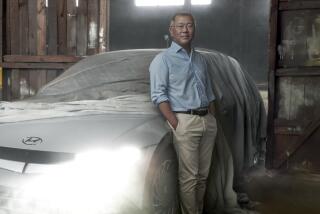Detroit Auto Show: Hyundai unveils 2 hybrid Sonatas, wild truck concept
- Share via
Hyundai used the 2015 Detroit Auto Show to show off three new models: two you can count on seeing soon, one that’s a bit of a stretch.
The two sure things are the new hybrid version of Hyundai’s Sonata midsize sedan, and the company’s first plug-in hybrid Sonata model. The oddball is the Santa Cruz crossover truck concept thing.
First, reality.
The new Sonata hybrid uses a 2.0-liter, four-cylinder engine and a six-speed automatic transmission, paired with a 38 kW electric motor for 193 total horsepower. The car is expected to get 39 mpg in the city and 44 mpg on the highway, a 10% boost over the previous generation Sonata Hybrid, Hyundai said.
Notably, Hyundai was able to relocate the battery pack from between the rear seats and the trunk to the floor of the trunk. The new Sonata now allows the rear seats to fold flat, and they’re split 60/40.
This is a major improvement over the earlier Sonata and other midsize sedan hybrids that put the battery between the rear seats and the trunk space, preventing the seats from folding for extra cargo room and cutting into trunk space. Hyundai said moving the battery boosted trunk space by 10%.
Meanwhile, the Sonata plug-in hybrid adds the extra feature of all-electric driving and plug-in recharging. Using a similar power train as the regular hybrid model, the Sonata plug-in offers 202 total horsepower. It can travel up to 22 miles on electric power alone, and recharges in about five hours using a standard 110-volt outlet.
Hyundai says its internal testing rates the Sonata plug-in at 93 MPGe, a nice bump over Ford’s Fusion Energi plug-in, which is rated at 88 MPGe. Once the battery is depleted and recharging, the Hyundai will get 38 mpg in the city and 43 mpg on the highway.
The Sonata plug-in will also come with an app that lets smartphone users remotely set charge times, turn the car on, and sync Google maps with the car’s navigation system. The car will be available towards the end of 2015 in California, Connecticut, Maine, Maryland, Massachusetts, New Jersey, New York, Oregon, Rhode Island and Vermont. No pricing details were announced.
Then there’s the Santa Cruz crossover truck concept. Picture a sleek, modern Chevy El Camino on stilts with two full-size doors and two small, rear-hinged doors.
Hyundai was hurt in the last year by being a car-centric brand even as the market shifted to favor trucks and sport-utility vehicles, said Dave Zuchowski, chief executive of Hyundai Motor America.
It’s making a push to get a larger share of the South Korean automaker’s SUV and crossover production to sell in the U.S. market and is looking at new options such as the Santa Cruz concept vehicles it showed in Detroit, Zuchowski said.
The marketing team at Hyundai believes there is a large population of consumers who don’t see themselves driving a pickup. Either the vehicles are too large and hard to park in the urban environments where these drivers live or they are too expensive — a typical well-equipped full-size pickup can approach a $40,000 sticker price.
Yet these consumers still want truck-like features in a vehicle such as the ability to toss lumber, dirty bikes, kayaks and other equipment in the back without spoiling the auto’s interior, said Mark Dipko, director, corporate planning, Hyundai Motor America.
A unique feature of the Santa Cruz is a section that expands out the rear of the vehicle, increasing the size of the cargo bed to almost that of a midsize pickup truck.
“This new crossover allows them all the expandable utility they need throughout their active week, from work-life professionalism, to social interests, to a whole variety of outdoor pursuits,” he said.
Hyundai created the truck-crossover mashup because “we didn’t want to cover the same ground as a tradition truck,” Dipko said.
Honda said something similar when it launched its Ridgeline crossover truck in 2005. That trucklet was discontinued in 2014. Honda has said it will resurrect the model in a more traditional truck layout in late 2015 or 2016.
Hyundai doesn’t currently have plans to put the Santa Cruz into production, content to simply use the concept to gauge consumer reaction.






